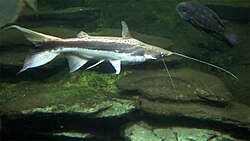This article includes a list of references, related reading, or external links, but its sources remain unclear because it lacks inline citations .(November 2022) |
| Sorubim lima | |
|---|---|
 | |
| Scientific classification | |
| Kingdom: | Animalia |
| Phylum: | Chordata |
| Class: | Actinopterygii |
| Order: | Siluriformes |
| Family: | Pimelodidae |
| Genus: | Sorubim |
| Species: | S. lima |
| Binomial name | |
| Sorubim lima (Bloch & Schneider, 1801) | |
| Synonyms [2] | |
| |
Sorubim lima is a species of fish of the Pimelodidae family in the order Siluriformes.

